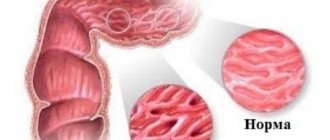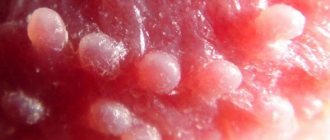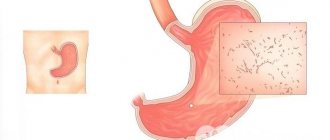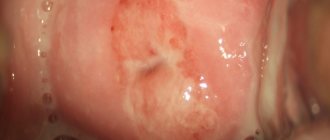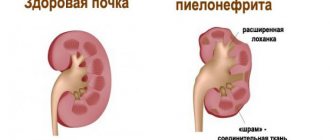Chronic vaginitis is an inflammation of the vagina, usually of infectious origin, characterized by a long course.
According to statistics, about 30% of women of reproductive age currently suffer from vaginitis, and this figure is increasing every year. This pattern is explained by the deterioration of the environment and, as a consequence, a decrease in the body’s defenses.
It is worth noting that many women who have not completed treatment for acute vaginitis think that they have already recovered. In fact, the pathological process has become chronic. Patients learn about this when they have to see a doctor about complications arising from chronic vaginitis. During remission, the symptoms of chronic vaginitis are almost completely absent or they are not clearly expressed. Therefore, women may not have the disease treated for months, and sometimes years. Exacerbations of vaginitis usually occur after the body has been exposed to any adverse factors, such as stress or infectious diseases.
Most often, the disease does not affect the general condition of the body. However, this does not mean that chronic vaginitis does not need to be treated. Many women suffer from infertility precisely because of chronic vaginitis.
Why does the disease develop?
The vagina is adapted for friction by the penis and serves to receive sperm and carry it into the uterus. It is a muscular tube lined from the inside with fairly strong multilayered epithelium. The upper layer of mucosal cells contains a large amount of glycogen as a reserve of carbohydrates. They are necessary to nourish the normal microflora of the vagina - Dederlein rods or lactic acid rods.
Bacteria break down glycogen and release lactic acid into the vaginal cavity. This system creates double protection against infections: Dederlein bacilli abundantly cover the mucous membrane and do not leave room for the proliferation of other microorganisms, and the acidic environment is destructive for most bacteria. In addition, the mucous membrane cleanses itself daily. Its cells produce a small amount of mucus, which flows down the walls and takes with it the desquamated epithelium, dead normal microflora and pathogenic representatives.
The amount of glycogen in mucosal cells depends on the concentration of sex steroids in the blood. Estrogen causes increased deposition, and progestogens, on the contrary, reduce the concentration of carbohydrates in the epithelium. The concentration of progestogens is highest before menstruation, so most acute vaginitis and relapses of chronic vaginitis occur at this time.
Thus, the vagina is reliably protected from the influence of pathogenic agents. However, the disease affects a large number of women every year. Provoking factors for vaginitis contribute to this:
- perineal injuries after childbirth and operations, due to which the walls of the vagina no longer close tightly and its opening gapes;
- pregnancy, childbirth, abortion, ovarian hypofunction, menopause - any conditions associated with a decrease in the concentration of estrogen in the blood;
- serious illnesses, infections, severe stress, psycho-emotional shock - all these factors lead to a significant decrease in a woman’s immune defense;
- non-compliance with personal hygiene rules - pathogenic bacteria multiply intensively in secretions, menstrual blood and can cause inflammation in the vagina;
- metabolic disorders (diabetes mellitus) – leads to excessive deposition of carbohydrates in the mucous membrane, itching of the perineum, deterioration of healing processes;
- neglect of a condom during casual sex often ends in vaginitis caused by pathogens of sexually transmitted diseases.
Complications
In the absence of timely medical intervention or poor quality treatment, complications of the inflammatory process may develop:
- transition from an acute form to a chronic form, which is more difficult to treat and more often causes relapses;
- colpitis can provoke the development of cervical erosion, cysts and other neoplasms;
- the infection can spread to parts of the urinary system and cause the development of chronic diseases (cystitis, pyelonephritis, etc.);
- development of endometriosis;
- in girls, as a result of colpitis, adhesions (synechias) of the labia majora and minora appear, making urination difficult and requiring surgical intervention;
- in elderly women, due to colpitis, hypoxia of the vaginal walls develops, as a result of which small ulcers and bruises form on the mucous membrane;
- inflammatory diseases, both infectious and non-infectious, provoke the development of secondary infertility.
- Gynoflor - instructions for use, composition, indications, side effects, analogues and price
- Extracellular and intracellular diplococci - routes of infection, symptoms, diagnosis and methods of therapy
- Salvagin - instructions for use and release form, indications, composition and side effects
What happens during inflammation?
Vaginitis is an inflammatory disease, but the cause of inflammation is not always pathogenic microorganisms. It is caused by any damaging factors that injure the walls of the vagina. For example, rough sexual intercourse, inaccurate douching, the use of aggressive detergents for intimate hygiene. The cause of inflammation can also be an allergic reaction to lubricant, contraception, tampons.
The infection enters the vagina in two ways:
- ascending - from the perineum, from the labia minora and majora, through the vestibule of the vagina, from the anus or urethra;
- descending - from foci of chronic infection in the body along with the blood or lymph flow (carious teeth, chronic tonsillitis, pyelonephritis).
Biologically active substances are released from destroyed epithelial cells. They dilate blood vessels, causing local stagnation of blood. The permeability of the vascular wall increases and immune cells - leukocytes and liquid blood plasma - enter the tissue through it. Swelling of the vaginal mucosa develops, and if severe damage occurs, it affects both the muscular and outer layers of the organ.
Decomposition products affect sensitive nerve receptors located in the mucosa. The impulse from them becomes more intense and the woman feels discomfort. Compression of the receptors by edematous tissue transforms it into itching or pain.
Secretory cells of the epithelium begin to intensively produce mucus in order to wash away pathogenic bacteria and cell decay products from the surface of the mucosa. Clinically, this process is manifested by vaginal discharge. If a significant part of the leukocytes dies and purulent inflammation develops, then an admixture of pus appears in the mucus. The destruction of small vessels of the mucous membrane gives the discharge a bloody character. STI pathogens cause specific inflammation with characteristic discharge from the genital tract.
What is the disease
Vaginitis is an inflammation of the vaginal mucosa caused by various factors. This is such a common pathology that almost every woman encounters it throughout her life.
Signs of vaginitis (colpitis) are not always clearly expressed. Often the disease is asymptomatic, which is why the woman does not seek medical help.
Chronic vaginitis is characterized by long periods of remission, during which there are no obvious manifestations of the disease. This condition can last for years, infectious agents are in an inactive state. But as soon as a provoking factor appears, an acute or subacute process develops.
The disease has virtually no effect on the general condition of the body. However, chronic vaginitis is often the cause of infertility, since long-term infection in the vagina tends to spread upward.
Trichomonas and candidal vaginitis are common types of pathology
The following types of this pathology are distinguished:
- infectious;
- non-infectious.
Infectious vaginitis is caused by pathogenic and opportunistic microorganisms.
Opportunistic microorganisms are part of the normal flora of the vagina, but they cause inflammation only under certain conditions - when the acidity of the environment changes.
Pathogenic microflora is divided into nonspecific and specific. Nonspecific pathogens include:
- staphylococci;
- streptococci;
- coli;
- candida;
- herpes virus.
It is nonspecific microflora that most often becomes the cause of chronic vaginitis.
Specific pathogens:
- gonorrheal bacillus;
- Trichomonas;
- chlamydia;
- mycoplasma;
- ureplasma.
Separately, bacterial vaginosis is distinguished. This is a type of infectious vaginitis caused by a violation of the composition of the vaginal microflora. The pathogen itself is not identified, but opportunistic microorganisms may be found in increased numbers in the vaginal microflora. Under their influence, the mucous membrane becomes inflamed, and characteristic signs of the disease appear. In some cases, bacterial vaginosis occurs without symptoms.
Non-infectious inflammation of the vaginal mucosa can develop under the influence of various provoking factors:
- Allergens and chemicals - latex, intimate hygiene products.
- High temperature - when douching with hot water.
- Urine - with genitourinary fistulas, when the contents of the bladder regularly enter the vaginal lumen.
Non-infectious also includes atrophic vaginitis, which can develop in older women due to vaginal dryness caused by a deficiency of sex hormones.
Causes and treatment of nonspecific vaginitis - video
What forms of colpitis exist?
According to the duration of the disease there are:
- acute vaginitis – lasts no more than 2 months;
- subacute vaginitis – inflammation persists for more than 2 months, but not more than six months;
- chronic - lasts more than 6 months, colpitis takes on a wave-like character: periods of complete calm are followed by exacerbations.
Depending on the cause of inflammation:
- bacterial vaginitis (nonspecific) – it is caused by opportunistic streptococci, staphylococci, bacilli;
- trichomonas - develops when infected with Trichomonas vaginalis, the causative agent of trichomoniasis;
- gonorrheal - it is caused by gonococcus, the causative agent of gonorrhea;
- mycoplasma - it is caused by the intracellular parasite mycoplasma, sexually transmitted;
- yeast - develops during the multiplication of the opportunistic yeast-like fungus candida, the causative agent of thrush;
- atrophic vaginitis - its cause is a decrease in the concentration of estrogen in the blood of a woman during menopause, with hypofunction of the ovaries or in case of their removal;
- allergic vaginitis - develops after allergens enter the vaginal mucosa and the immune cells react to them.
Types of vaginitis according to the nature of inflammation:
- serous - clear, liquid discharge;
- mucous – the discharge is thick, viscous, whitish, cloudy;
- purulent vaginitis - thick, yellow or yellow-green discharge, opaque with an unpleasant odor.
Classification
There is no single recognized classification of bacterial vaginitis among gynecologists. The following gradations of the disease are most often used.
By origin:
- specific - develops when obligate pathogens enter the body: trichomonas, chlamydia, candida, gonococci, viruses, mycoplasmas, ureaplasmas;
- nonspecific - provoked by an imbalance of normal vaginal microflora, opportunistic microorganisms displace lactobacilli.
Depending on the focus of development:
- primary - develops directly in the vagina;
- secondary - descending, if the inflammation “descends” from the uterine cavity, and ascending, if it “rises” from the vulva area.
According to the form of occurrence, the following variants of vaginitis are distinguished.
- Spicy. Characterized by pronounced symptoms. The pathological process can spread to the vulva area and the cervical canal.
- Subacute. It is an intermediate form between acute and chronic colpitis. Conventionally, it occurs within a period of several weeks to two months from the onset of the disease. Symptoms become less pronounced, but changes in the vaginal mucosa continue. If left untreated, colpitis progresses to the following form.
- Chronic. There are no symptoms of vaginitis, but episodes of exacerbation periodically occur. The condition is dangerous due to dysfunction of the reproductive system and problems with conception and pregnancy.
- Recurrent. Variant of the chronic form. Occurs due to incorrectly prescribed or incomplete treatment. And also due to sexual reinfection.
Based on etiology and detected pathogens, the following forms of bacterial vaginitis in women are distinguished.
- Trichomonas. It is caused by trichomonas, which are transmitted through unprotected sex. Less often - through household items (towels, underwear).
- Candida. Fungi of the genus Candida can normally be present in the vagina in small quantities. In unfavorable conditions (for example, with a decrease in immunity, after an illness, against the background of diabetes), fungi begin to actively multiply and cause inflammation. Candidal colpitis is not a sexually transmitted infection, but unprotected contacts during an exacerbation of the disease can provoke the appearance of symptoms in a partner.
- Atrophic. It occurs against the background of estrogen deficiency in women in natural or artificial menopause.
- Chlamydial. Occurs after infection with chlamydia. Pathogens quickly spread throughout all parts of the reproductive system, causing endometritis, salpingitis, and oophoritis.
- Mycoplasma. Can be caused by mycoplasmas and ureaplasmas. It has minimal clinical manifestations and is often discovered by chance.
- Gonorrheal. Gonorrhea is not limited to inflammation in the vagina - the external genitalia, cervix and uterine cavity, and appendages are affected.
How does the disease manifest?
Symptoms of vaginitis depend on the cause of the inflammation and its severity. General health in women, as a rule, does not suffer. Fever rarely exceeds 37-38. High fever, general weakness, severe pain in the perineum indicate inflammation of all the walls of the vagina and the fatty tissue surrounding the uterus.
Bacterial
It is otherwise called aerobic vaginitis, since inflammation is caused by opportunistic microflora, among which aerobic bacteria predominate. Their metabolism requires oxygen, so they usually live on the surface of the skin of the perineum. Unfavorable factors affecting the body allow aerobes to penetrate the vagina and multiply on its mucosa. They cause purulent inflammation with copious yellow-green discharge.
When examining the vagina, spots of hyperemia (redness) are visible on the mucous membrane, the walls are swollen and covered with pus. The reaction of vaginal discharge is acidic. The smears reveal key cells - epithelial cells completely covered with bacteria. There are few or no Doederlein sticks. Nonspecific vaginitis often becomes chronic, in which a woman is bothered by moderate, slightly yellow discharge for years.
Trichomoniasis
Trichomonas vaginitis develops 3-12 days after unprotected sex with a sick person. The incubation period can last up to a month. After asymptomatic accumulation of the pathogen, the clinical picture of acute vaginitis develops.
A woman develops profuse, foamy, foul-smelling discharge that is whitish or yellowish in color. They are accompanied by severe itching of the perineum, discomfort, and pain in the lower abdomen. Trichomonas is a mobile microorganism and can rise from the vagina into the uterus, fallopian tubes and peritoneal cavity. In this case, the pain in the lower abdomen intensifies, the temperature rises to 38-39 C, and the menstrual cycle is disrupted.
When examining the vagina, a uniformly hyperemic mucous membrane and swelling of the walls are visible. In some places they are covered with foamy secretions. Sometimes colpitis is almost asymptomatic, only upon examination a slight hyperemia of the mucous membrane is detected.
Gonorrheal
The pathogen is transmitted sexually, the first signs of vaginitis appear 3-4 days after unprotected sex. The woman experiences pain, burning in the vagina and profuse mucopurulent discharge. The latter may contain whitish films - layers of rejected mucosal cells.
Upon examination, swollen and hyperemic walls of the vagina are visible; on their surface there may be numerous small bright red papillae. In severe cases, dense whitish films are found on the mucous membrane, after removal of which bleeding erosion remains. The patient develops bloody discharge.
Yeast
Candidal vaginitis is familiar to the vast majority of women. They often blame their sexual partners for the disease, but is vaginitis sexually transmitted? The yeast-like fungus Candida is a representative of opportunistic microflora and lives asymptomatically in the vagina of every fifth woman. It can cause inflammation only with a significant decrease in immunity, metabolic disorders and hormonal status.
First, severe itching and dryness of the vagina appear. If the labia majora swell and become painful, it means that fungal vulvovaginitis has joined the colpitis. After a day or two, characteristic discharge appears: white, in the form of grains of cottage cheese with a sour smell. Their abundance may vary; in some cases, vaginitis occurs without them at all.
Typically, a fungal infection is activated before menstruation or during pregnancy. Its unpleasant feature is the frequent chronicity of the process, as a result of which the woman experiences relapses of the disease several times a year.
Atrophic
Most often it is postmenopausal, that is, it develops during menopause. It differs from other vaginitis in the painful itching and dryness of the vagina. The discharge is scanty, mucous, transparent, odorless. When examining the vagina, a pale yellow mucous membrane is visible, on the surface of which there are hemorrhagic spots - bruises. The vagina is narrowed, connective tissue adhesions form in the area of the posterior fornix.
Chronic
Chronic vaginitis, regardless of the cause, proceeds through stages of calm and exacerbation. The symptoms are mild, the discharge is scanty or moderate, they have bothered the woman for years. Long-term inflammation significantly changes the walls of the vagina. They become denser, their elasticity decreases, and they become rough.
Symptoms
Signs of the development of colpitis can be different and depend on the stage of development of the disease, the age of the patient and the reason that provoked the development of the pathology. Any infectious lesion of the internal and external genital organs in a woman is accompanied by itching, burning, specific discharge, redness of the mucous membrane, pain when urinating and during sexual intercourse.
Chronic
The disease may go unnoticed by the woman for a long time, or the symptoms may appear briefly and insignificantly. If left untreated, chronic vaginitis can cause the development of infectious diseases in the genitourinary system (bladder, kidneys). In addition, after some time, strong periodic exacerbations of colpitis begin: severe burning, swelling, pain in the lower abdomen, thick, foul-smelling discharge.
- Vulvovaginal candidiasis - causes, diagnosis, treatment and prevention
- Vaginal suppositories-tablets Vaginorm-S
- What to do for vaginal dryness: remedies
Spicy
The clinic of acute inflammation is characterized by rapid development of symptoms. The woman begins to feel burning, itching, pain when urinating and during sex. During the examination, swelling of the mucous membrane can be detected. The presence and nature of the discharge is determined by the causative agent of colpitis. In some cases, the patient’s body temperature rises to subfebrile levels.
Non-specific
In addition to the classic manifestations, damage to the vaginal and vulvar mucosa, nonspecific colpitis is accompanied by symptoms of the primary disease (for example, severe weight gain or weight loss due to hormonal disorders). In this case, it is necessary to carry out additional diagnostics to clarify the diagnosis. Nonspecific vaginitis has an acute course, but its symptoms are mild.
Diagnostics
Diagnosis of vaginitis is the task of a gynecologist. He makes a diagnosis based on the patient’s complaints, her anamnesis, examination data and examination results. When examined in the mirrors, he determines the pH of the vagina with litmus paper: values above 5.0 indicate a violation of the vaginal microflora.
The doctor takes a smear, which is then examined in the laboratory under a microscope and inoculated on nutrient media. Colonies of bacteria that grow after 3-5 days make it possible to accurately determine the pathogen and its sensitivity to antibiotics. To diagnose sexually transmitted infections, vaginal discharge is examined by PCR. It allows you to detect the genetic material of the pathogen in a sample and accurately determine its type.
Prevention of vaginitis (colpitis) during pregnancy
To prevent vaginitis from occurring during pregnancy, it is better to be treated at the planning stage. Take the necessary tests, including a smear for flora. An extended popular study of microflora is Femoflor. It shows both normal representatives living in the vagina (the same Dederlein bacilli, which play the role of protection against “strangers”), as well as opportunistic (ureaplasma) and pathogenic bacteria.
If any symptoms of vaginitis appear during pregnancy, then in women who pay enough attention to planning and taking tests, they will be easier. The gynecologist will prescribe safe local remedies that are permitted during this exciting and important period. Sometimes severe forms of infection can prevent natural delivery, and a cesarean section is prescribed.
Vaginitis is a disease like any other, so don’t be embarrassed to seek help. Self-medication is a waste of time and can be dangerous. With such an arsenal of tools available to modern gynecology, women are simply obliged to live and enjoy their intimate life and motherhood. Most examination methods do not cause much discomfort. If you wish, you can even be examined anonymously. Now there are many private laboratories that perform tests quickly and conveniently for patients, without queues and unnecessary stress. Their network is especially wide in large cities.
Did you know?
If a teenage girl over 15 years of age experiences vaginitis, she has the right to contact a pediatric gynecologist without her parents. Gentle methods will be used for examination and treatment, and any damage will be excluded.
Treat yourself with love. Be healthy!
How to cure vaginitis?
Treatment of vaginitis is carried out on an outpatient basis; sick leave is not required. If pathogens of sexually transmitted infections are detected, not only the woman, but also her sexual partner undergoes treatment. An indispensable condition for treating vaginitis is complete sexual rest. It is important not only to eliminate inflammation, but also to restore damaged microflora, immune defense and remove the influence of the causative factor (sanitize foci of chronic infection, change personal hygiene products or contraception, compensate for diabetes with insulin).
The treatment regimen includes local and systemic drugs. Antibiotics are used in the treatment of bacterial vaginitis:
- for nonspecific - Amoxicillin tablets, Clindamycin vaginal suppositories;
- for trichomonas - orally Ornidazole, Metronidazole, local Tinidazole;
- for fungal infections - fluconazole once orally, vaginal suppositories Metamycin, Isoconazole, Econazole. Pregnant women use local drugs - Natamycin, Etroconazole.
After a course of antibiotics, a woman is shown vaginal suppositories with lactobacilli - Acylact, Laktonorm. They are necessary to restore the usual microflora and immune defense of the vagina.
Additionally, douching is prescribed with:
- soda – 2 tsp. per glass of water, after 20-25 minutes - with a weak solution of potassium permanganate;
- Zn sulfate – 2 tsp. a glass of water for purulent discharge;
- protargol solution 3-10% - the medicine is used for persistent discharge with pus;
- borax solution 1-3% - the product helps with candidiasis.
A woman is recommended to take sitz baths once a day for 10-15 minutes with a decoction of chamomile, calendula, St. John's wort, and oak bark. To relieve pain and itching, suppositories with indomethacin are used.
It is difficult to cure chronic vaginitis, which recurs over years. In addition to the course of standard therapy, the gynecologist uses physical therapy methods (magnetic therapy, UHF, electrophoresis), includes immunomodulating therapy, and prescribes vitamins. Women with chronic inflammation are advised to undergo treatment in sanatoriums and resorts.
Diagnostic methods
Microsporia of a vaginal smear is the most informative method. But some infections can only be detected by PCR analysis (polymerase chain reaction), their causative agents are so small. It is better to do such a study once a year when visiting a gynecologist. The fact is that some infections occur hidden. Only a few pathogens manifest themselves actively, especially with recent infection.
Trichomonas (a sexually transmitted disease) produces a characteristic yellow-green discharge with foam. If you have candidal vaginitis, you will notice loose white flakes on your underwear that resemble cottage cheese. Don’t think that taking one pill can solve the problem here. This is a marketing ploy.
Read also Annual medical tests for women
Disease prevention
Prevention of vaginitis includes:
- suppression of transmission routes of pathogenic bacteria - use of condoms during casual sexual contacts, Miramistin for douching after sex with a new partner;
- maintaining personal hygiene - using soft products to care for the perineum, moderate douching only when necessary, changing pads during menstruation at least once every 4 hours;
- correction of hormonal levels in case of ovarian pathology or during menopause.
Vaginitis is dangerous only for pregnant women if it is severe and often recurs. In this case, the infection can penetrate the membranes and infect the baby. Timely and adequate treatment is necessary to prevent such an outcome of colpitis.
Treatment of vaginitis
Usually the doctor prescribes local, as well as antibacterial and anti-inflammatory drugs in the form of tablets. If necessary, local or general hormonal therapy is prescribed. Immunomodulators may be prescribed, usually in the form of suppositories to enhance immunity and suppress opportunistic flora. Such flora suppresses the natural microflora in the vagina, although in itself it does not cause harm. The number of beneficial bacteria decreases, and they need to be populated with beneficial lactobacilli and other microorganisms that normally live there. For this purpose, there are suppositories with bifidobacteria and lactobacilli. It is useful to consume more fermented milk products, fruits and vegetables, and give up sweets and baked goods.
If you are often plagued by fungal infections, then you should check the condition of your intestines and thoroughly review your diet. Also, the number of fungi increases in immunodeficiencies. When fungal flora is detected, antifungal drugs are prescribed, for example, Miconazole, Fluconazole and its analogues. If the causative agent is Trichomonas, Metronidazole is used for suppression. If an allergy is identified, it is important to find its source: intimate gels, sprays, wipes or underwear.
Physiotherapy and sanatorium treatment are prescribed according to indications. If vaginitis is chronic, then it is better to go to a gynecological sanatorium when the process subsides, during the period of remission. Baths, mud baths or therapeutic showers may be prescribed.
After completing the course of treatment, which lasts about a week, you need to take repeated tests. With chronic vaginitis, relapses are possible. You should prevent their occurrence by reducing the amount of alcohol you drink, avoiding hypothermia and using a condom during sexual intercourse.
If a woman suffers from chronic vaginitis, her likelihood of contracting HIV and hepatitis increases several times. This is due to the fact that during sexual intercourse the mucous membrane is additionally injured and a certain amount of blood may be released. Viruses easily enter the bloodstream. Usually, when examining women with chronic forms of vaginitis, several pathogens are detected at once, but no beneficial bacteria are detected. Treatment becomes more complicated, you have to take several medications, and liver protection is required.
Read also: Menopause: how to relieve symptoms and survive it with minimal losses
How to treat vaginitis
Taking into account the cause of vaginitis, local and extensive drugs are used for treatment. So, local treatment is prescribed baths with chamomile extract. In the presence of purulent discharge, rinsing with a soda solution containing 2 teaspoons per glass is used for local treatment. And also subsequent douching with a solution of potassium permanganate. If the discharge has a strong specific odor, the vagina is washed using zinc sulfate and copper sulfate. At the end of purulent discharge, it is necessary to use binding solutions. If complications arise, vaginal baths can be used, the course of which must take at least two days.
In cases of postmenopausal vaginitis, a solution of chamomile or boric, lactic acid is used.
If recurrent vaginitis occurs, the use of estrogen hormones is recommended, which should be taken for up to two weeks in small doses (up to 0.5 mg). A gynecologist can prescribe antibiotics only after checking the pathogen’s response to them. Their use is usually topical in the form of a solution.
Diet can help prevent the disease. So, due to excessive consumption of fats and carbohydrates, the development of recurrent vaginitis is much higher. Fatty meats, butter, margarine, cream, and confectionery products should be removed from the diet.
In cases where gonococci (Neisseria gonorrhoeae) are sensitive to tetracyclines, use amoxicillin in doses of 3 grams and probebecid in doses of 1 gram no more than once a day. The use of benzylpenicillin salt is carried out once with its administration intramuscularly. In some cases, doxycyline is used in doses of 100 grams twice a day.
If gonococci do not respond to the use of antibiotics, kanamycin is used with the introduction of two grams intramuscularly. Also, 2.5 g of thiamphenicol is administered orally over a period of two days. In addition, sulfomethoxazole can be used in a dose of 10 tablets over a period of three weeks.
If the spread of gonococci is particularly severe, ceftriaxone is used once in a dose of 250 milligrams or cephalosporin. In rare cases, 500 mg of ciprofloxacin is administered once.
For inflammation caused by Trichomonadida, use metronidazole in an amount of 2 grams once. The same drug is given to sexual partners. When using the drug, drinking alcohol is strictly contraindicated.
The use of metronidazole to treat vaginitis during pregnancy in the first trimester is prohibited.
To treat vaginitis, an adjuvant can be used - Gynocomfort Gel with tea tree essential oil. Specialists from the pharmaceutical company VERTEX took part in its development. The gel has all the necessary documents and quality certificates. The product passed clinical trials at the Department of Dermatovenereology with the clinic of St. Petersburg State Medical University under the leadership of Ignatovsky A.V. and Sokolovsky E.V.
Vaginitis in pregnant women
Diagnosis of colpitis
To make a diagnosis of colpitis, it is important to first interview the patient in great detail about her complaints and collect an anamnesis of the disease, as well as a life history. After this, you can proceed directly to the inspection.
- A gynecological examination is performed by a doctor using special instruments. The patient is in a gynecological chair.
- Colposcopy is an examination of the vagina and cervix using a diagnostic device (colposcope). During the study, an image is displayed on the screen, enlarged 30 times.
- Examination of a vaginal smear and culture from the vaginal mucosa allows one to assess the presence of inflammation and draw a conclusion about the causative agent of the disease.
- Blood testing for the presence of specific antibodies against pathogens of sexually transmitted infections. This study helps in diagnosing colpitis and finding its cause.
With yeast (candidal) colpitis, upon examination, swelling and hyperemia (redness) of the mucous layer of the vagina and cervix are noted. White discharge of a cheesy nature is noticeable. When performing colposcopy, a diagnostic sign of candidal colpitis is the detection of pinpoint inclusions on the mucous membrane, reminiscent of semolina. The most informative is the examination of smears and culture of vaginal contents, which can directly identify the culprit of the disease. Auxiliary methods for diagnosing candidiasis colpitis are the study of intestinal biocenosis and examination for concomitant sexually transmitted infections.
Trichomonas colpitis in the acute stage can be suspected during a gynecological examination. The vaginal mucosa is swollen, red, and there is a yellow-gray foamy discharge. Colposcopy allows you to see small hemorrhages and erosions of the cervix. Trichomonas itself can be easily detected by microscopy of a vaginal smear. You can use the PCR (polymerase chain reaction) method to diagnose trichomoniasis.
Gonococcal colpitis can be suspected based on anamnestic data and relevant complaints. During a vaginal examination, redness and swelling of the mucous membrane and the presence of specific purulent discharge, which can be from both the vagina and the urethra, are noted. The pathogen itself can be detected using bacterioscopic and bacteriological methods.
It is very difficult to diagnose chlamydial colpitis based on symptoms alone. The examination also does not show any specific signs. Therefore, it is important to examine scrapings from the urethra and cervical canal to directly identify the pathogen.
Nonspecific colpitis during a gynecological examination looks like this: attention is drawn to the redness and swelling of the vaginal mucosa and the presence of pathological discharge of a purulent and mucopurulent nature. When you touch the mucous membrane, it bleeds. In severe cases, erosions and ulcers of the mucous membrane may form. The bacteriological diagnostic method helps to identify the pathogen.
Chronic colpitis upon objective examination looks like this: redness and swelling of the mucous membrane are not very pronounced, they are much less than during the first examination in the acute stage. Infiltrates of the papillary layer of the vagina (small elevations above the surface of the mucosa) can be detected. Colposcopy is very helpful in diagnosis, during which even mildly expressed inflammatory signs do not go unnoticed.
If atrophic colpitis is suspected, then its symptoms are the main diagnostic criteria. The woman’s medical history, combined with complaints and objective examination data, allows us to make a diagnosis. The bacteriological diagnostic method helps to identify an opportunistic pathogen that has taken the place of normal lactobacilli.
Consequences for the body
Both bacterial vaginitis and bacterial vaginosis are not an immediate threat to a woman’s body. However, they lead to the reproduction and accumulation in the lower parts of the genital tract in high concentrations of opportunistic and pathogenic microorganisms, which subsequently cause the development of purulent-inflammatory processes in the uterus and appendages, lower parts of the urinary tract, pelvioperitonitis and infertility.
Bacterial vaginitis during pregnancy can lead to such obstetric and gynecological complications as:
- ectopic pregnancy;
- miscarriage;
- chorioamnionitis (infection of the amniotic membrane and amniotic fluid);
- prenatal rupture of amniotic fluid and premature birth (the risk increases by 2.5-3.5 times);
- intrauterine infection of the fetus;
- pathology of a purulent-inflammatory nature in the immediate postpartum period (develops 3.5-6 times more often).
Bacterial vaginitis after childbirth occurs quite often, which is explained by an increase in the pH of the vaginal environment and changes in the ratio of microorganisms of the lower genital tract, constant changes in general hormonal levels, and a weakening of local and general immunity.
Types of vaginitis
- By pathogen:
- Bacterial (specific) - develops when the microflora is disrupted and a large number of bad bacteria begin to multiply in the vagina, exceeding the permissible level. Often occurs when Candida or Trichomonas fungi are transmitted through sexual contact;
- Fungal – Candida fungus;
- Viral;
- Nonbacterial (nonspecific) – redness (irritation) of the skin in the vaginal area;
- Atrophic – decreased estrogen.
- For reasons:
- Infectious is divided into subtypes:
- Bacterial vaginosis – copious milky discharge with a specific fishy odor;
- Nonspecific vaginitis - pain and heaviness in the pelvis, discharge of varying consistency: purulent, watery, foamy, thick, fetid;
- Gonorrheal vaginitis;
- Candidal vaginitis is caused by a yeast-like fungus called candida, which often causes the disease. The discharge is curd-like, whitish, thick, with or without odor. Itching appears, intensifying when walking, during menstruation, at night;
- Trichomonas vaginitis is a foamy purulent discharge with a strong fishy odor, itching, burning, and pain when urinating.
- Non-infectious - provoked by various thermal, mechanical, chemical and allergic factors. Contact with dirt and even feces can cause illness.
- By age of patients: Girls;
- Women of childbearing age;
- Women of the postmenstrual period. By factors preceding the disease: After an abortion;
- After childbirth;
- After operations;
- Due to allergies. By exudate:
- Serous;
- Serous-purulent;
- Gangrenous.
go to top
Treatment of colpitis in women
For the disease “colpitis”, treatment in women is complex. Medicines are prescribed for the treatment of colpitis that not only eliminate the very cause of the disease, but also increase the body's defenses.
In most cases, it is recommended to suspend sexual activity during treatment for colpitis. Sometimes sexual activity is allowed, but only with the use of condoms. You need to find out immediately at your doctor’s appointment whether your sexual partner needs to be examined and treated.
When treating virgins, local medications are used that can be used without disturbing the integrity of the hymen.
The criteria for recovery are not only the disappearance of symptoms of colpitis, but also negative results of microbiological testing.
Specific drugs for the treatment of colpitis
Specific treatments for colpitis in women are drugs that directly fight the pathogen. In this case, both local and general therapy can be prescribed.
Bacterial inflammation is treated by prescribing antibacterial drugs. If colpitis is viral, treatment includes drugs that have an antiviral effect. In case of fungal infection of the vaginal mucosa, antifungal agents are needed to treat colpitis. Colpitis caused by protozoa requires the prescription of drugs that have a detrimental effect on them.
- Douching with antiseptic solutions (chlorhexidine, betadine, miramistin, etc.) is often used.
- Local use of suppositories, ointments, gels, vaginal tablets that contain drugs that directly combat pathogens (antibacterial, antifungal, antiprotozoal, antiviral drugs)
- Many drugs have a complex effect, that is, they fight bacteria, fungi, and protozoa. Examples of such drugs are Polygynax, Nifuratel, Neo-penotran, Terzhinan, etc.
- If inflammation is caused by anaerobic or mixed flora, then drugs containing metronidazole, clindamycin, ornidazole, etc. have a good effect.
- Systemic antibacterial therapy for the treatment of colpitis is selected after identifying the pathogen, taking into account its sensitivity to antibiotics.
Treatment of candidal colpitis
If a woman is diagnosed with candidal colpitis, how to treat it? When colpitis is acute, the treatment is local: drugs are prescribed in the form of suppositories, vaginal tablets, and creams. All medications for the treatment of candidal colpitis contain an antifungal drug. Examples of such drugs are Diflucan, Ginofort, Pimafucin, Terzhinan and many others. Systemic antifungal drugs are prescribed for chronic or recurrent vaginal candidiasis.
Treatment of trichomonas colpitis
How to treat Trichomonas colpitis? Both sexual partners are treated at once, even if nothing is found in the second. Specific drugs for the treatment of colpitis of trichomonas etiology are drugs containing tinidazole, ornidazole, metronidazole. They are taken orally, in tablets. In addition, local medications are prescribed that help in the fight against Trichomonas. As a rule, these are combined antimicrobial drugs.
Treatment of gonococcal colpitis
If a patient is diagnosed with gonococcal colpitis, how to treat it? When treating gonococcal colpitis, systemic administration of antibiotics of different groups is used, as well as local therapy, which involves instillation of antiseptic solutions into the urethra and vagina. Treatment is long and often takes place in a hospital.
Treatment of chlamydial colpitis
When diagnosing chlamydial colpitis, how should the patient be treated?
When treating chlamydial infection, antibiotics are mandatory, most often from the macrolide group (azithromycin, erythromycin). Antiseptic drugs are prescribed locally.
Stages and types
Many women live with trichomonas vaginitis without knowing it. The initial stage is asymptomatic, sometimes itching occurs, and menstruation may be delayed. During this period, there is a high probability of colonization of the vaginal microflora with microorganisms from the external environment. At the second stage, lactobacilli decrease, the gram-variable environment increases, and leukocytosis is moderate. The decompensated stage of chronic inflammation is characterized by the absence of lactobacilli, acute manifestations of symptoms, and various combinations of microorganisms are located in the microflora.
There are several areas of the disease. Depending on the origin of the causative agent of vaginal inflammation, the following types of disease are distinguished:
- Specific bacterial vaginosis. Changes in microflora occur due to the presence of several types of pathogenic microorganisms in the vagina. The causative agents of a specific form of the disease include Trichomonas, gonococcus, and mycoplasma genitalium.
- Nonspecific bacterial colpitis. Appears due to the active growth of pathogenic bacteria in the vagina. A nonspecific infection occurs during pregnancy, when the level of progesterone, testosterone and estrogens in the body decreases, when Candida albicans (candidal vaginitis) and yeast fungus actively multiply.
Features of vaginal microflora
The normal microflora of a woman is a collection of microorganisms (microbiocenosis) that occupy various ecological niches: the skin and mucous membranes, i.e., the places of contact of the human body with the external environment. Excessive growth of bacteria or appearance in unusual places is a signal of the onset of pathological changes.
One of the main indicators of a woman’s reproductive health is normal vaginal microflora. The interaction of microorganisms with the epithelial layer of the vagina is ensured not only at the cellular, but also at the molecular level.
The vaginal microflora is a variety of bacteria present in every woman on the mucous membrane of the internal genital organs.
Vaginal microbiocenosis is characterized by the predominance of lactobacilli, the absence of gram-negative flora, spores and mycelium of yeast-like fungi, the presence of single leukocytes and “pure” epithelial cells.
Colpitis during pregnancy
A woman who is carrying a child has a much higher risk of developing colpitis. After conception, the corpus luteum begins to produce progesterone, which suppresses the immune system in order to create favorable conditions for implantation. During pregnancy, the disease not only causes physical discomfort, but also poses a threat to the life of the child. Pathogenic bacteria affect the kidneys and urethra, which complicates the process of pregnancy. Rising along the cervix to the uterine area, they penetrate into the amniotic fluid, preventing the child from developing normally.
Forms
Any inflammatory process has several main forms. Bacterial vaginitis is no exception.
- Acute type. It starts quickly and develops at lightning speed. It can be identified by symptoms. The main symptom is high temperature. This form of the disease is curable with proper medication.
- Chronic type. Appears if acute bacterial vaginitis is not treated. There are no obvious symptoms. There is no discomfort, there are practically no unpleasant sensations either. It can turn into an acute form at any time. It is very difficult to get rid of the problem.
Regardless of the pathogen that caused the disease, one form or another of the problem may manifest itself.
Symptoms of colpitis in women
The insidiousness of colpitis is that they very often occur asymptomatically or with similar clinical symptoms, which include discomfort in the vagina, dysuric disorders, pathological discharge from the genital tract, and sexual disorders.
Therefore, doctors do not diagnose colpitis only on the basis of the patient’s complaints, although they are very important. After interviewing the patient, the gynecologist proceeds directly to the examination and then prescribes the necessary tests.
Dietary recommendations
A woman may lack some vitamins and minerals. To make up for their deficiency, you should consume as much as possible:
- vitamin B (nuts, legumes, liver, spinach, garlic, mushrooms);
- vitamin C (sea buckthorn, currants, oranges, lemons, etc.);
- vitamins A and E (sweet potato, broccoli, seaweed, dried fruits, etc.);
- magnesium (seafood, nuts);
- zinc (buckwheat and oatmeal, beans, peas, poultry, lamb, etc.);
- calcium (cheese, cream, barley, etc.).
During the treatment of bacterial vaginitis, as well as for its prevention, it is recommended to limit the consumption of sweets and alcohol, which can aggravate the therapy.
What is bacterial vaginitis
A common gynecological disease in which the vaginal microflora changes is bacterial vaginosis; every third woman suffers from it. This is not an inflammatory disease. Fungi, gonococci and other pathogens are not found in the discharge. There is a change in the balance of bacteria: conditionally pathogenic microflora increases, and the number of lactic acid bacteria decreases. This provokes a decrease in the protective barrier of the vagina, creating a suitable background for the development of inflammatory diseases of the uterus.
Reasons for the development of vaginitis
Gynecologists identify a wide range of causes for the development of inflammation and an impressive number of factors predisposing to its occurrence. But all of them are associated with a decrease in the body’s immune properties and an imbalance of the natural microflora of the vagina.
The following reasons contribute to the development of inflammation:
- previous injuries to the perineum, postpartum or postoperative period. At this time, the walls of the vagina are not closed tightly enough, and the opening is gaping;
- pathological and physiological conditions accompanied by changes in the level of estrogen in the blood - childbirth, pregnancy (or its termination), impaired functional ability of the ovaries, menopause;
- severe illnesses, infectious processes, psycho-emotional shock, constant exposure to a stressful environment. This group also includes insomnia, violation of the work and rest schedule;
- insufficient compliance with the rules of intimate hygiene. The accumulation of pathogenic microflora is a natural phenomenon for the body of every woman. But it requires immediate elimination, since there is a high probability of infection of the vagina and reproductive organs. The greatest concentration of pathogenic microorganisms is characterized by vaginal discharge and menstruation;
- an equally common cause of the inflammatory process is intolerance to lubricants, contraceptives, and hygienic tampons;
- reluctance to use barrier contraception (condoms) during casual intimate relationships.
Lubricants, contraceptives, hygienic tampons as a cause of vaginitis.
Impaired metabolism, endocrine disorders, and diabetes mellitus often contribute to vaginal damage.
These phenomena cause excessive production and subsequent deposition of carbohydrates on the surface of the mucous membrane. The accumulation leads to increased itching of the genitals and a slowdown in the healing process of tissues damaged during scratching.
Treatment
The wide range of manifestations of vaginosis predetermines non-standard treatment regimens. The decision to prescribe the necessary treatment is made only by the doctor. The choice of treatment method should take into account not only the presence of the main disease, but also the presence of secondary diseases that may occur.
Bacterial vaginitis is an imbalance in the vaginal microflora and the proliferation of pathogenic bacteria. Accordingly, measures when choosing treatment should be aimed at eliminating these indicators.
Treatment consists of two stages:
- Antibacterial therapy aimed at eliminating opportunistic microflora.
- Restoring the patient's health.
Treatment can be varied. In parallel with drug therapy, doctors often recommend the use of traditional medicine.
How to treat bacterial vaginosis - video
Conservative therapy
When the clinical picture of the disease is pronounced, antibiotic drugs are used. It can be:
- Metronidazole and its structural analogues;
- Amoxiclav;
- Neomycin;
- Ceftriaxone;
- Gentamicin;
- Clindamycin;
- Cefixime;
- Ofloxacin.
Metronidazole is a popular prescription for the treatment of bacterial vaginitis.
Before prescribing antibiotics, a study is carried out to determine the sensitivity of the vaginal mucous flora to them.
To restore the flora, it is often recommended to simultaneously use drugs based on lactic acid bacteria, for example, Lacidophil, Bifiform, Bifiliz, Bifidumbacterin (including in ampoules), Yogurt, Linex, Lactobacterin. The use of these prebiotics is a prerequisite for the successful treatment of vaginal dysbiosis present in bacterial vaginitis. This will prevent the development of complications.
Physiotherapy helps in achieving positive results in the treatment of bacterial vaginitis. The following procedures are usually prescribed for this:
- UHF therapy of genitals and perineum;
- contact irradiation of the vulva with a laser;
- UV irradiation of the external genitalia.
Local treatment is the use of vaginal suppositories, douching solutions, baths, and gels. Usually the doctor prescribes a multi-step regimen for the use of various medications, such as:
- antibacterial suppositories, creams and capsules: Terzhinan, Vokadin, Polygynax, Ginalgin, Bepanten, Pimafucin, Klion-D, Ginoflor E, Ginocomfort, Vaginorm, Dalatsin;
- antiseptic solutions for douching: Chlorhexidine (Hexicon), Miramistin, Citeal, Hydrogen peroxide, Chlorophyllipt, Furacillin, Potassium permanganate;
- vaginal baths using antiseptic solutions;
- suppositories with lactic acid bacteria to restore vaginal microflora: Simbiter, Acylact, Vagilak, Bifolak, Zhlemik, Femilex.
A more promising area of treatment are vaginal prebiotics that stimulate the growth of a woman’s own lactoflora (Vapigel, Lactagel).
Folk remedies
Traditional medicine helps speed up recovery and get rid of the problem. All kinds of decoctions and infusions used for vaginal baths and/or douching are prepared from herbal raw materials:
- Infusion of celandine herb for baths: 2 tablespoons of crushed raw materials are poured with a liter of boiling water, left for a long time: at least three hours. Cool, filter and use in full.
- Infusion of horsetail herb: 2-3 tablespoons of this phyto-raw material is poured into 0.2 liters of boiling water. Infuse in a warm place or thermos for three hours. Cool, squeeze, filter. Apply in full, adding boiled water to the required volume.
- A decoction for douching based on walnut leaves: 50 g of leaves are poured with cold water in an amount of 1 liter and brought to a boil. Leave for an hour, cool and filter.
- An infusion for irrigating the vagina from a herbal collection: crushed thyme leaves, chamomile flowers and oak bark are mixed in a ratio of 3:5:5. The mixture is infused for 20 minutes, poured with boiling water (two tablespoons of the mixture is a liter of water), then filtered, cooled and used.
- A decoction for douching based on a mixture of oak bark, sage flowers, yarrow leaves and rosemary, mixed in a ratio of 2:1:1:1. Pour 2 tablespoons of the mixture into 1 liter of water, bring to a boil and simmer for 5 minutes over low heat under a lid. Use after cooling and squeezing in full.
- Infusion of chamomile and plantain for douching: mix the herbs in equal parts, then pour 2 tablespoons of the raw material into two glasses of boiling water. Leave for 1 hour, then filter, cool and use as directed.
- A decoction of St. John's wort for vaginal baths or douching: 2-3 tablespoons of the raw material are boiled for 20 minutes over low heat in two liters of water. Apply after straining, after cooling.
- Decoction of calendula flowers: 2 tablespoons of herbs are poured into one glass of water and boiled for 10–15 minutes. Strain, cool and use freshly prepared.
Healing plants in the photo
In Rus', St. John's wort was considered a herb for a hundred ailments
Calendula has a powerful antiseptic effect
Thyme is contraindicated during pregnancy
Chamomile decoction can be used externally or taken internally
Walnut leaves are a strong antiseptic and wound healing agent.
Horsetail helps remove lead and various toxic substances from the body, improves water-salt metabolism
Celandine is used as an anticonvulsant, anti-inflammatory, analgesic, and bactericidal agent
It should be remembered that the effectiveness of treatment for bacterial vaginitis depends on the complexity of measures. Only a combination of drug therapy and the use of traditional methods can relieve the disease in the shortest possible time.
During the period of treatment, some restrictions and rules should be observed:
- If a woman is undergoing therapy, then the man should contact a urologist or venereologist for prevention.
- During the treatment period, you should avoid sexual contact or use condoms to prevent the possibility of permanent infection.
- Correction of all kinds of immune disorders in a woman’s body is an important point in the treatment of any gynecological diseases.
Treatment of acute vaginitis: tablets, suppositories and others
After the test results are received, the gynecologist determines the treatment regimen. Depending on the causative agent of vaginitis, the treatment process for an acute condition can last from 7 to 10 - 15 days. Then the woman will have to take control tests again.
Modern pharmaceutical products make it possible to prescribe different groups of drugs during the treatment of vaginitis. Their action is aimed at:
- elimination of the pathogen;
- increasing general immunity;
- normalization of the microflora of the vaginal and intestinal mucosa.
If the cause of colpitis is bacteria, you cannot do without antibiotics. They will need to be taken in a course, the duration of which will be determined by the doctor. You cannot make adjustments to the regimen of taking such medications on your own, as this may reduce the effectiveness of treatment for vaginitis.
Approximate treatment regimen for bacterial vaginitis
Traditionally, medications must be used topically. A specialist can prescribe vaginal tablets, suppositories or creams that will relieve the woman of the source of inflammation and relieve unpleasant symptoms. During their use, you will have to limit your sex life and carefully conduct personal hygiene. It is recommended to abandon the usual intimate cosmetics during the treatment of vaginitis - not only deodorants, but also gels.
Taking probiotics will be useful for restoring female microflora. Depending on the scale of the problem, these may be dosage forms or fermented milk products, the shelf life of which does not exceed three days, as well as special immunomodulators and vitamins. Often, for women who experience vaginitis during menopause, gynecologists prescribe hormonal drugs based on estrogen.
For information on the diagnosis and treatment of vaginitis, watch this video:
Symptoms and signs
The first symptoms and signs of vaginitis of the vaginal mucosa are unpleasant itching sensations in the genital area. Redness and swelling of the genitals begin to be observed. There is copious vaginal discharge. Intimate relationships with men become painful.
Common features are:
- Redness and enlargement of the mucous membrane;
- Pain in the genital area;
- Copious discharge of leucorrhoea, possibly even with blood;
- Unpleasant odor;
- Burning and itching of the genitals.
The chronic form occurs only in the form of copious discharge that emits an unpleasant odor. In this case, pain and itching in the vaginal area are practically not observed. This form of the disease is long-lasting and subsequently relapsing. The asymptomatic nature of this form can be misleading, making it clear that the woman is not sick. However, if there is pain during sexual intercourse, walking or active movements, then you should consult a gynecologist.
Associated symptoms may include:
- Frequent urination;
- Temperature increase;
- The appearance of blood in the discharge.
go to top
Vaginitis in a man?
This is an exclusively female disease; a man cannot suffer from the same symptoms due to physiological characteristics. Representatives of the stronger half of humanity may also have inflammatory diseases of the genital organs, but they have completely different causes than vaginitis. Symptoms of inflammatory processes in men appear very rarely, unless we are considering the Trichomonas variant. In this case, both partners need to be treated. Bacterial and candidal colpitis does not occur in men, again due to the same structural features of the genital organs, that is, such a disease is purely female.
Folk remedies
Vaginitis can be treated with folk remedies. This method of therapy reduces the risk of allergic reactions, but all procedures must be carried out with the permission of a doctor; self-medication is dangerous to health. The following traditional medicine methods are used:
- Douching. A tablespoon of chamomile, plantain, and cinquefoil is poured with boiling water and left for about 30 minutes. The mixture is filtered and used morning and evening. You can use oak bark, bird cherry, juniper fruits, and walnut foliage.
- Tampons. A pre-prepared piece of gauze is soaked in herbal remedies: aloe juice with olive or sea buckthorn oil in a 1:1 ratio. The drug is inserted into the vagina before bed and left there for 7-8 hours.
- Baths. Taking water procedures helps relieve the symptoms of the disease. It is necessary to immerse yourself waist-deep in a bath with herbal decoction every day. A mixture of oat straw, chamomile, and flower honey gives a good effect.
- Infusions to strengthen the immune system. To improve the body's defense mechanisms, a composition is prepared from quince, cherries, lemon, garlic, and apples. All ingredients are ground, mixed with boiling water, and infused for about half an hour. The infusion is used four times a day, 100 ml.
Complications of pathology, incl. during pregnancy
Vaginitis in itself cannot be called a comfortable condition. It can greatly worsen the quality of life of any woman and seriously undermine her health. The fact is that the inflammatory process in the vagina can “rise” higher and cause:
- cervical erosion;
- damage to the inner layer - endometritis;
- adnexitis;
- complete or partial obstruction of the fallopian tubes.
In little girls, vaginitis is one of the factors influencing the appearance of synechiae (fusion of the labia). And in older women, it provokes trauma to the vaginal walls, due to which ulcerations begin to appear there.
The disease can also affect the function of the bladder and kidneys, causing them to become inflamed. However, the most serious consequence of untreated vaginitis is the inability to have children due to infertility or miscarriage. This happens with untreated colpitis when the infection spreads.
While expecting a baby, a woman's body is most vulnerable. In addition to the fact that there is a physiological decrease in immunity, hormonal levels also change. Therefore, vaginitis becomes a frequent companion of expectant mothers. This condition absolutely cannot be ignored. The pathogen can penetrate the placenta and harm the baby, causing premature rupture of amniotic fluid or intrauterine infection of the child, as well as during childbirth.
However, you should not self-medicate. Only a doctor can identify the true cause of vaginitis and choose the right therapy. The list of drugs that can be used during pregnancy is small, but it will relieve the mother of unpleasant symptoms without harming the baby.
Causes and factors influencing it
As mentioned above, there can be many causes of bacterial vaginitis. The underlying factor is various infections or an unusual reaction to irritants. In addition to the development of the disease, disturbances in the functioning of the whole organism occur. Often, bacterial colpitis of one type is accompanied by a secondary infection.
Trichomonas vaginalis is often found in association with mycoplasmas (47.3%), gonococcus (20.9%), chlamydia (18.2%), and fungi (15.7%).
The development of the disease process is influenced by various factors:
- weakening of the body after childbirth;
- recurrent abortions and miscarriages;
- “young” menopause;
- gynecological diseases;
- decreased immunity due to various colds;
- the presence of sexually transmitted infections;
- various blood diseases;
- unhealthy lifestyle with alcohol abuse and smoking;
- eating disorders;
- stressful situations and psycho-emotional shocks;
- hormonal and endocrine disorders, in particular diabetes;
- frequent change of sexual partners;
- disturbances in the structure of the genitals;
- lack of personal hygiene;
- frequent douching using non-sterile instruments;
- long-term use of antibiotics and antibacterial drugs;
- therapy with cytostatic agents;
- tendency to allergies;
- consequences of radiation therapy;
- poisoning and intoxication.
The incidence of bacterial vaginosis is highest among young and sexually active women.
Bacterial vaginosis can be considered as an infectious non-inflammatory syndrome, characterized by a sharp decrease or absence of lactoflora and its replacement with pathogenic microorganisms.
In bacterial vaginitis, the following bacteria are usually present:
- gardnerella;
- bacteroides;
- fusobacteria;
- Klebsiella;
- staphylococci;
- streptococci and others.
Despite the fact that colpitis is considered a female disease, men can be carriers of the infection. If a woman who is sexually active exhibits symptoms of vaginosis, both partners should consult a doctor for treatment.
Prevention
There are no specific measures to prevent subacute vaginitis. In order to reduce the risk of vaginal inflammation, you must:
- use a condom;
- do not drink alcohol and drugs;
- exercise;
- undergo regular gynecological examinations;
- maintain optimal body weight;
- eat more dairy products, vegetables, fruits and meat;
- regularly wash with warm water after urinating;
- change pads more often during menstruation;
- change underwear daily;
- drink vitamins;
- stop smoking;
- eliminate stressful situations;
- eliminate foci of chronic infection;
- treat enterobiasis;
- avoid hypothermia;
do not abuse douching and taking hormonal medications;
- refuse abortion;
- increase immunity;
- refuse pads and tampons with fragrances;
- Do not take antibiotics and corticosteroids without a doctor's prescription.
It is important to monitor hormonal levels and promptly treat endocrine pathologies.
